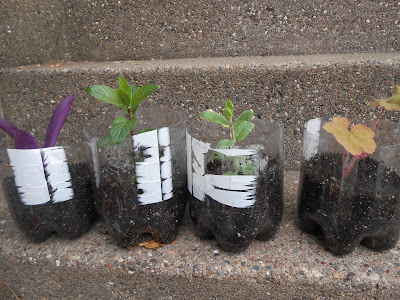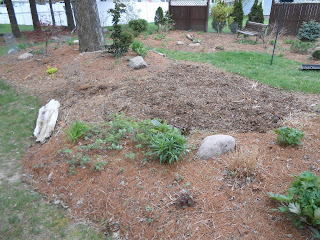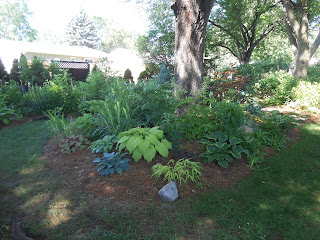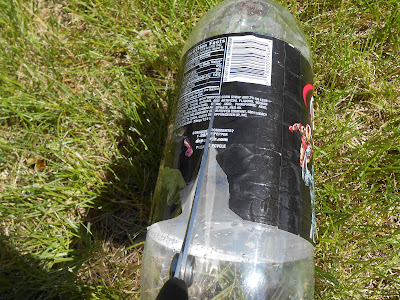I love growing plants from seed but sometimes it isn't feasible to do this. Some plants won't come true from seed while others might be sterile and not set seed at all. Another reason is also time. In some cases it takes time to grow out a plant from a seed. This is where propagating from cuttings of the plant works out beautifully. Some people shy away from propagation of plants by cuttings because they think it is difficult or it might take a long time. Well, it doesn't. In some cases you can get a plant cutting to begin rooting in as little as a few days. One example of an easy to root plant is Mint and another would be Lemon Balm, but almost anything can propagated from a cutting. I have used my method on just about anything including herbs, houseplants, perennials and shrubs (softwood cuttings).
 |
| Cuttings grown in 2 liter bottles |
The method of propagation I use involves the use of a 2 liter bottle and cuttings. For a cutting to take root humidity/moisture levels must be maintained and the 2 liter bottle keeps the cutting all warm and moist until it sends out new roots. You can do it inside anytime or outside (in the shade) when it is warm out-Spring and Summer are the perfect time to expand you plant collection. Just follow my steps and you will have success at propagating your plants from cuttings too!
Here is what you will need:
 |
| Supplies to propagate plants easily |
1. 2 liter bottles
2. Sterile rooting medium-I use Pro-Mix All Purpose Growing Mix but you can use perlite, course sand or your favorite seed starting mix
3. Clean scissors and something to poke holes in the bottom of the 2 liter
4. Water
Here are the steps to propagate your own plants:
1. Clean the 2 liter bottle (make sure to put the cap back on) and remove the label.
2. With a screwdriver, ice pick or scissors poke holes in the bottom of your bottle.
3. Using the scissors, cut the 2 liter bottle in half.
4. Cut 3 or 4 slits in the top half of the 2 liter like this:
It should fit over the bottom like this:
 |
| 2 liter propagator |
5. Fill the bottom half of the 2 liter with sterile medium.
 |
| 2 liter propagators ready for cuttings |
6. Wet the rooting medium thoroughly and let drain. Do not use any fertilizer.
7. When the rooting medium in the bottom half of the 2 liter has drained set it to the side. Clean your scissors.
8. Find a candidate for propagation. If you are new to this start with something easy like Mint, Basil, Coleus, or Lamium.
9. Cut a piece off that has at least 3 sets of leaves. Cut off below a set of leaf nodes if possible or if propagating Heuchera you need a piece of the crown.
 |
| Taking a cutting from Chocolate Mint |
 |
| Chocolate Mint cutting |
 |
| Heuchera cutting |
 |
| Tradescantia pallida cutting |
 |
| Pineapple Mint |
10. Rinse the cutting off. I like to spray mine down first with a solution of water mixed with Dawn and epsom salts in a spray bottle to ensure no critters are hiding on the leaves. After I spray with the solution I then rinse off really well.
 |
| Use a spray bottle filled with water, squirt of DAWN, and a pinch of Epsom salts to "clean" plant |
 |
| Rinse cuttings off with water |
11. Trim off the bottom leaves or excess stem.
 |
| Pineapple mint cutting trimmed |
 |
| Chocolate mint cutting trimmed |
 |
| Heuchera cutting trimmed up with a piece of crown attached |
12. Stick the cutting in the rooting medium and press the soil to make sure there is contact with the cutting.
 |
| Place Chocolate Mint cutting into rooting medium |
 |
| Place Heuchera in rooting medium |
13. Place the top of the 2 liter over the bottom and place either in a shady spot outside or in a sunny window inside. I also do this under my seed starting setup which uses flourescent lights.
 |
| 2 liter propagators |
14. Monitor the 2 liter bottle and make sure it stays moist. I usually will set it in a tray of water if it isn't "foggy" or humid in the bottle. Remember you need the cuttings to stay moist.
15. After about a week check the bottom of the bottle. Sometimes you can start to see roots form in the bottom especially with the easy to root plants. If you don't see any roots don't worry. As long as the cutting isn't wilting it is still alive and doing okay. Sometimes if you give it a little tug you will notice it is resistant to coming out. Just be patient. Most plants will start to send out roots within 2-3 weeks.
 |
| Roots of propagated plant |
 |
| Roots of propagated planted |
16. When you can see roots in the bottom of the bottle it is time to acclimate the plant to the outside air. It will have to adjust to the change in humidity levels so remove the top for a couple of hours at a time for a few days until it gets used to drier air. This is also true for the sun. You will have to "harden off" the plant before you plant it back in full sun. During this whole process do not let the soil dry out-keep well watered.
 |
| Chocolate Mint roots after 1 week |
 |
| Lemon Thyme roots after 1 week |
 |
| Heuchera roots after 2 weeks |
17. After the plant is adjusted to the outside air and sun you can now plant it or pot it up. The following plants were rooted and ready in 2 weeks: Pineapple Mint, Chocolate Mint and Tradescantia pallida. The Lemon Thyme and Heuchera will take more time to develop enough roots to survive-at least another 2 weeks.
 |
| Propagated plants potted up after less than 3 weeks |
18. Just remember that not all plants will root quickly-be patient. Even if it takes a month to root you will still have a more substantial plant than if you had started the plant from seed.
I hope I have persuaded you to go out and take some cuttings and give this method a try. Nothing is more rewarding than propagating your own plants, and using a 2 liter bottle is the cheapest and easiest way to do it. Heck, 2 liter bottles are an essential tool for us gardeners-I also use them for seed starting. So, next time you have a 2 liter bottle use it to make more plants! If you have any questions or comments feel free to leave them below.
Until next time-Happy Gardening!
Rhonda

































































